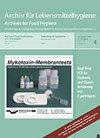Identification of Enterobacteriaceae and Cronobacter spp. in raw milk, milk concentrate and milk powder: prevalence and genotyping
IF 0.2
4区 农林科学
Q4 CHEMISTRY, APPLIED
引用次数: 13
Abstract
Cronobacter spp. (former Enterobacter sakazakii) are occasional contaminants of powdered infant formula (PIF) and have been implicated in rare cases of neonatal infections. Surveys on the prevalence of these organisms and/or contamination routes during the processing of the infant formula are of importance to the manufacturers in order to reduce the level of contamination of these products. Increasing customer awareness on possible contamination of other milk powder based products intended for consumption by (older) infants posed the question about the presence of Enterobacteriaceae and especially Cronobacter spp. in products other than PIF e. g. milk concentrate (intermediate) and milk powder, both added to a variety of infant foods. It was the aim of this study to create data on the prevalence of Enterobacteriaceae and possible epidemiologic correlation of Cronobacter spp. in raw milk, milk concentrate and milk powder obtained from a Swiss milk powder production facility (2 production sites). A total of 100 raw milk samples, 91 milk concentrate samples and 172 milk powder samples were collected and tested for the presence of Enterobacteriaceae including Cronobacter spp. by cultural means. Subsets of isolates from each sample category were selected for further molecular identification and subtyping analysis. A variety of members of the Enterobacteriaceae family were observed in all types of samples, whereas Cronobacter spp. was isolated from milk powder only. Subtyping revealed a relatively high degree of heterogeneity among Cronobacter spp. isolates from both production sites suggesting continuous entry and dissemination of organisms from the production environment into the products.原料奶、浓缩奶和奶粉中肠杆菌科和克罗诺杆菌的鉴定:流行率和基因分型
克罗诺杆菌(原阪崎肠杆菌)是婴儿配方奶粉(PIF)的偶然污染物,在罕见的新生儿感染病例中也有涉及。在婴儿配方奶粉加工过程中,对这些微生物的流行程度和/或污染途径进行调查,对于制造商降低这些产品的污染水平非常重要。消费者对(年龄较大)婴儿食用的其他奶粉产品可能受到污染的认识日益提高,这就提出了一个问题,即在PIF以外的产品中存在肠杆菌科,特别是克罗诺杆菌,例如添加到各种婴儿食品中的浓缩牛奶(中间)和奶粉。本研究的目的是建立肠杆菌科的流行率和克罗诺杆菌属的可能的流行病学相关性数据,这些数据来自瑞士奶粉生产设施(2个生产基地)的原料奶、浓缩奶和奶粉。收集了100份原料奶、91份浓缩奶和172份奶粉样品,通过培养方法检测了包括克罗诺杆菌在内的肠杆菌科细菌的存在。从每个样本类别中选择分离物亚群进行进一步的分子鉴定和分型分析。在所有类型的样品中均观察到多种肠杆菌科成员,而克罗诺杆菌仅从奶粉中分离到。分型结果显示,来自两个生产地点的克罗诺杆菌分离株具有相对高度的异质性,表明生物从生产环境持续进入并传播到产品中。
本文章由计算机程序翻译,如有差异,请以英文原文为准。
求助全文
约1分钟内获得全文
求助全文
来源期刊

Archiv Fur Lebensmittelhygiene
工程技术-毒理学
自引率
0.00%
发文量
0
审稿时长
>12 weeks
期刊介绍:
The "Journal of Food Safety and Food Quality“ provides a platform for papers including case studies and discussion papers dealing with topics from all areas of food hygiene (food originating from animals) including dairy hygiene, food monitoring, beef cattle and meat examination, meat hygiene and food technology.
 求助内容:
求助内容: 应助结果提醒方式:
应助结果提醒方式:


